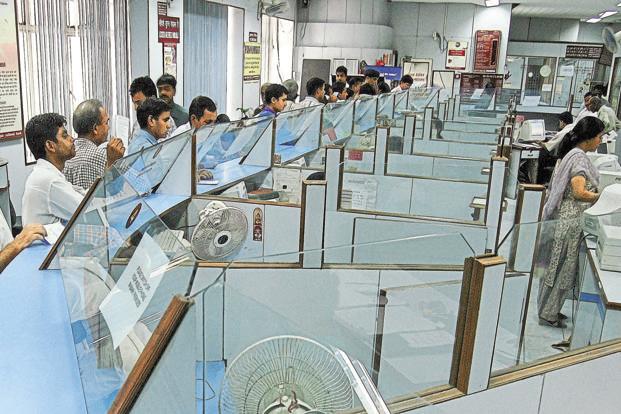Net profits of the 30 constituents of BSE’s benchmark 30-share Sensex have grown 19.3% in the June quarter from a year earlier, in line with analysts’ estimates, but the banking sector has disappointed investors. The combined net profit of 40 listed Indian banks has grown just 3.12%, and 13 banks—three from the old private sector and 10 from the public sector—have actually recorded a drop in net profits in the quarter. The drop in net profits for eight banks has been between 54% and 82%.
Profit growth has been slender, year on year as well as quarter on quarter, despite the fact that they have set aside less money to cover bad loans in the June quarter than what they had in the year-ago period. Collectively, these listed banks have set aside Rs.16,526 crore in the June quarter of 2014 to take care of their bad assets, 8% less than what they had set aside for the same purpose in the same quarter of 2013. Compared with the March quarter, when these banks had provided for Rs.25,502 crore, the June quarter provision has seen a sharp 35% drop. In other words, had the banks continued to set aside a hefty amount for bad assets, their net profits would have remained flat or even declined.
However, lower provisions should not give one the impression that the banks have finally got a grip on their bad loans. In fact, their bad loans have been on the rise. Before we discuss that, let’s take a look at the banks’ net interest income, an outcome of their bread-and-butter business of giving loans. Forty listed banks’ net interest income in June has grown close to 11%, from Rs.58,351 crore to Rs.64,719 crore. The quarter-on-quarter rise, however, has been less than 1%. The rise in net interest income has, to some extent, been nullified by a sharp drop in fee income. So-called other income, which largely consists of fees and commission, has dropped 10.24% in the June quarter to Rs.23,828 crore.
There seems to be no respite from rising bad loans. The gross non-performing assets (NPAs) of 40 listed banks in the June quarter has grown some 21% in absolute terms to Rs.2.52 trillion from Rs.2.08 trillion in the year earlier. In the March quarter, the pile of gross NPAs was Rs.2.42 trillion, 4.24% less than the June figure. After taking into consideration the money set aside for bad loans, the growth in net NPAs in the June quarter from the year-ago period has been over 23%—from Rs.1.15 trillion to Rs.1.42 trillion. In the March quarter, net NPAs were to the tune of Rs.1.33 trillion.
State Bank of India (SBI) continues to have the largest share of gross NPAs—over Rs.60,000 crore—but the good news is, in absolute terms, the bank has been able to bring down its gross NPAs by 0.75% from a year earlier. In fact, compared with the March quarter, its gross NPAs are down 1.9%. Punjab National Bank, which accounts for Rs.19,602 crore gross NPAs, has seen a 30% rise in bad loans in the past one year. In fact, barring SBI and UCO Bank, all state-run and most private banks have recorded higher gross NPAs in absolute terms, and for some of them, the growth has been rather high. For instance, Union Bank of India’s gross NPAs have increased 44% to Rs.10,232 crore, that of Indian Overseas Bank 39% to Rs.10,351 crore, and IDBI Bank Ltd 35% to Rs.10,763 crore. Among others, Jammu and Kashmir Bank Ltd’s gross NPAs have nearly tripled, Bank of Maharashtra’s risen 151% and Corporation Bank’s NPAs have doubled.
Jammu and Kashmir Bank also takes the cake when it comes to growth in net NPAs in absolute terms, recording a rise of over 16 times—from Rs.56 crore to Rs.968 crore. ING Vysya Bank Ltd’s net NPA growth has been over four times to Rs.332 crore. The net NPAs of three other banks have at least doubled in the June quarter over the year-ago period.
In some sense, absolute growth in bad assets is a good indicator of a bank’s health, simply because NPAs as a percentage of assets can always be depressed if a bank’s overall asset growth is healthy. Both the gross and net NPAs of the banking system, as a percentage of assets, have grown in the first quarter of the current fiscal year when the Indian economy started showing some incipient signs of growth. Only 12 of the 40 listed banks have shown a drop in their gross NPAs in the June quarter while 28 have shown a rise. For Kolkata-based United Bank of India, the rise in gross NPAs as a percentage of assets has been 4.9 percentage points—from 5.59% to 10.49%. United Bank apart, there are at least seven public sector banks that have recorded more than 5% gross NPAs while old private sector Dhanlaxmi Bank Ltd has recorded 7.17% gross NPAs. The trend continues unabated as only one-fourth of listed banks have shown a marginal drop in gross NPAs in the June quarter over the March quarter.
The scene is no different when it comes to net NPAs. Here too, 10 banks have shown a marginal improvement in their bad loan figures, while for two of them—HDFC Bank Ltd and Kotak Mahindra Bank Ltd—figures have remained unchanged at 0.3%. United Bank tops the list with 7.23% net NPAs, followed by Dhanlaxmi Bank with 4.62% and seven other banks recording at least 3% or more net NPAs.
Investors are lapping up most bank stocks, anticipating better days ahead, but the reality seems to be lagging sentiment. It will take at least two more quarters for the banks to show an improvement in quality of assets.



